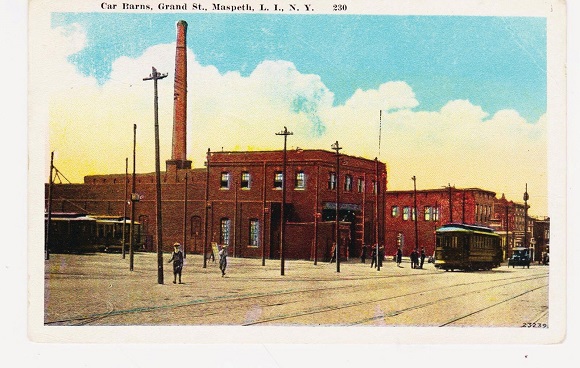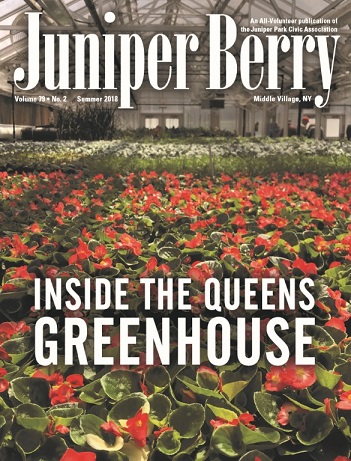The Maspeth Car Barn was located on the south side of Grand Street (now Grand Avenue) between what is now 69th Street and Brown Place. In July 1854 a horse car railroad started operating from the ferry landings in Williamsburg, along today’s Flushing Avenue, to Onderdonk Avenue which was the end of the line. In 1867 a horse car railroad laid track from Bushwick Avenue in Kings County and then along Maspeth Avenue and Grand Street in Maspeth to Maiden Lane (now Mazeau Street) but never got clearance to operate along this route. Finally, in August 1873 the tracks were pulled up.
In 1876 the Grand Street and Newtown Railroad, a horse car line, got a franchise and extended their service in Queens County along Grand Street in Maspeth and to the village of Newtown where they built a stable which held 98 horses. Nicholas Wyckoff (1799-1883) was the president of this railroad and also president of the 1st National Bank of Williamsburg. He was a highly respected businessman and lived on Flushing Avenue in what is now Ridgewood. He died in June 1883. On March 30, 1885, the railroad purchased land in Maspeth on the south side of Grand Street between what is now 69th Street and Brown Place from Peter Wyckoff, son of the late Nicholas Wyckoff. On the site in Maspeth the railroad erected a wooden car barn capable of holding 75 cars and in the same building but separated by a thick brick wall for fire protection, a stable to hold 168 horses in 84 double stalls. The building was 200 feet long and 163 feet wide. There was a waiting room for passengers and a blacksmith shop. When the depot opened in June 1885, the railroad divided the line into two parts. Originally, they charged a 5-cent fare from the village of Newtown to the ferry landings in Williamsburg. With the opening of the new Maspeth Depot, the depot in the village of Newtown was closed. There were nine tracks leading into the car barn, with two tracks from Newtown and two from Williamsburgh. They ran cars from Maspeth Depot to Williamsburg with 15-minute headway and charged a 5-cent fare. They ran separate cars from Maspeth Depot to the village of Newtown with 30-minute headway and charged a 5 fare. Needless to say, the residents of the village of Newtown were incensed.
Although the depot in Maspeth created jobs, it also created problems. The stables were cleaned daily, and the manure piled outside. At intervals the manure was loaded into rail cars for shipment to fertilizer dealers. However, in the summer months the odor from the manure piles and stable and the flies were a drawback to those residents who lived near the car depot.
When Nicholas Wyckoff died, he was succeeded by Eckford Webb as president of the railroad. About a year later, Martin Joost replaced him as president and in October 1888, Peter Wyckoff, son of Nicholas Wyckoff, became president and held this position until 1890 when he sold the rail road to the Brooklyn City Railroad Company. In April 1893 the Brooklyn City Railroad started constructing a large power plant in Ridgewood on Wyckoff Avenue between Putnam Avenue and Madison Street. By September of that year the plant was completed. It was designed to provide electrical power for the change-over from the horse car lines to electric trolleys in Ridgewood Maspeth and Newtown.
By April 1894, the poles and trolley wires had been installed and the horse car railroad at Maspeth Depot was converted over to electric trolleys. The stable area was converted over and also used for a car barn. This change made the area around the depot considerably more attractive as it eliminated the odors and flies. The line was extended north from the village of Newtown to Bowery Bay (North Beach). The Brooklyn end of the line was the Brooklyn Bridge. In 1898, the trolley cars went over the Brooklyn Bridge to Park Row in Manhattan which was the end of the line. The fare remained unchanged at 5c.
The electric trolley cars operated along this line until 1948 when buses replaced them. The car barn and depot were torn down when the Long Island Expressway was cut through in the 1950s. Frontera Park today sits on much of the former car barn site.
[For many years, George Miller, past president of the Greater Ridgewood Historical Society, shared fantastic history articles with us under the name of the organization. He passed away earlier this year and we offer our condolences to his family. He is, and will continue to be, greatly missed.]




